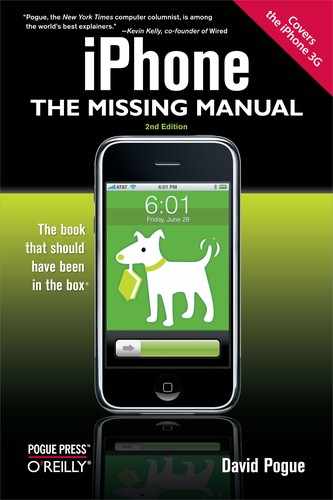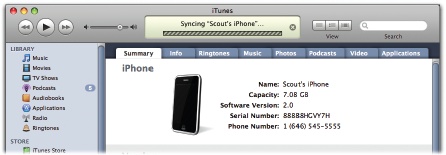When you get right down to it, the iPhone is pretty much the same idea as a PalmPilot: It's a pocket-sized data bucket that lets you carry around the most useful subset of the information on your Mac or PC. In the iPhone's case, that's music, photos, movies, calendars, address book, email settings, ringtones, and Web bookmarks.
Transferring data between the iPhone and the computer is called synchronization, or syncing. Syncing is sometimes a one-way street, and sometimes it's bidirectional, as you'll find out in a moment.
This chapter covers the ins and outs—or, rather, backs and forths—of iPhone syncing over a USB cable. (Syncing wirelessly, over the airwaves, is a treat reserved for MobileMe and Microsoft Exchange people, as described in Chapters Chapter 14 and Chapter 15.)
So how do you sync? You connect the iPhone to the computer. That's it. As long as the cable is plugged into your computer's USB port, iTunes opens automatically and the synchronization begins. iTunes controls all iPhone synchronization, acting as a software bridge between phone and computer.
Note
Your photo-editing program (like iPhoto or Photoshop Elements) probably springs open every time you connect the iPhone, too. See Shutting Down the Importing Process for the solution.
When the iPhone and the computer are communicating, the iTunes window and the iPhone screen both say "Sync in progress."
Unlike an iPod, which gets very angry (and can potentially scramble your data) if you interrupt while its "Do not disconnect" screen is up, the iPhone is much more understanding about interruptions. If you need to use the iPhone for a moment, just drag your finger across the "slide to cancel" slider on the screen. The sync pauses. When you reconnect the phone to the cable, the sync intelligently resumes.
In fact, if someone dares to call you while you're in mid-sync, the iPhone cancels the session itself so you can pick up the call. Just reconnect it to the computer when you're done chatting so it can finish syncing.
Now, ordinarily, the iPhone-iTunes relationship is automatic and complete. An automatic sync takes care of all of these details:
Contacts, calendars, and Web bookmarks. These data types get copied in both directions. That is, after a sync, your computer and phone contain exactly the same information.
So if you entered an appointment on the iPhone, it gets copied to your computer—and vice versa. If you edited the same contact or appointment on both machines at once while they were apart, your computer now displays the two conflicting records, and asks you which one "wins."
Music and apps bought from the App Store in iTunes, videos, ringtones, photos from your computer, and email account information. All of this gets copied only in one direction: computer→phone.
Photos takes with the iPhone's camera, music from the Wi-Fi iTunes Store (on the phone), and programs from the App Store (downloaded to the iPhone). All of this gets copied the other way: phone→computer.
A complete backup. In the iPhone 2.0 world, iTunes also takes it upon itself to back up everything else on your iPhone: settings, text messages, call history, and so on. That's why syncing takes so much longer than it did before the 2.0 update. (Details on this backup business on Backing Up the iPhone.)

